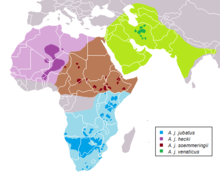Around 7,100 cheetahs remain, say experts
Thursday, December 29, 2016

Image: Charles Sharp.
According to a study published on Monday in the Proceedings of the National Academy of Sciences, the cheetah (Acinonyx jubatus), is down to 7,100 individuals remaining worldwide, most of them in Africa and, rarely, in Asia.
The number establishes cheetahs as much less commonplace than just over one hundred years ago. There are now scientists calling for the largest cheetah subspecies to receive "endangered" status on the International Union for Conservation of Nature (IUCN)'s Red List of Threatened Species.

Image: Mariomassone.
The US National Wildlife Federation reports an estimated worldwide population of 100,000 cheetahs in the late 19th century. The new study, led by Zoological Society of London (ZSL) researcher Sarah Durant, with contributors including the Wildlife Conservation Society (WCS) and Panthera Corporation, indicates a decline of more than 91%. Most of the remaining cheetahs live in most of Africa, more than half in southern Africa, while a subspecies is found in Asia, including a small part of Iran, though these are seen much more rarely.
According to the study's authors, the habitat preservation strategy that can be so effective in other species does not work on cheetahs because of their wide range. About 77% of wild cheetah's ranges are outside protected areas. According to Cheetah Conservation Project Zimbabwe, Zimbabwe's cheetah population dwindled from an estimated 1,500 in 1999 to 150–170 in 2013–2015, a roughly 85% decline. The group based its survey on such resources as photographs, tourist sightings, safari guides, cattle herders, and village chiefs.
The Asiatic cheetah (Acinonyx jubatus venaticus) has been nearly eliminated in Asia; under 50 Iranian cheetahs remain. The cheetah subspecies went extinct in India more than fifty years ago, says International Business Times.
The new study asks the IUCN to change the status of cheetah from "vulnerable" to "endangered" in an effort to protect cheetahs. The IUCN lists both the Northwest African cheetah (Acinonyx jubatus hecki) and the Asiatic cheetah as "critically endangered" in their Red List.

Image: Katie Hunt.
Causes of cheetah decline have been mostly habitat loss, killings of cheetahs by humans, human hunting of cheetah's resources such as antelope, illegal fur trade, illegal cub trafficking, and roadkill. According to the Cheetah Conservation Fund, about 85% of an estimated 1,200 trafficked cheetah cubs have died within the past ten years, perishing en route.

Image: Charles Sharp.
Their exotic aesthetic renders cheetah very valuable. A trafficked cub can fetch $10,000, according to the BBC. According to DW, cheetah skin and meat are valuable as well.
Complicating conservation efforts, cheetahs are carnivores and difficult to maintain in captivity. According to one report, the 77% of wild cheetah habitat is outside the range of protected wildlife areas and reserves. The cheetahs' secretive nature makes finding conclusive evidence on cheetahs difficult, says Durant.
Cheetah is the world's fastest springing species and predator. One cheetah was recorded sprinting at 29 meters (95.1 ft) per second. They slow down if needed to hunt, and can maintain high speeds for hundred of metres. The running speed of cheetahs has not prevented their decline.
Sources
- Himanshu Goenka. "Cheetah Facing Extinction As Population Drops, Experts Call For ‘Endangered’ Listing In IUCN Red List" — International Business Times, 27 December 2016
- "Cheetahs losing race away from extinction as African habitat shrinks" — DW, 27 December 2016
- Sarah M. Durant, Nicholas Mitchell, Rosemary Groom, Nathalie Pettorelli, Audrey Ipavec, Andrew P. Jacobson, Rosie Woodroffe, Monika Böhm, Luke T. B. Hunter, Matthew S. Becker, Femke Broekhuis, Sultana Bashir, Leah Andresen, Ortwin Aschenborn, Mohammed Beddiaf, Farid Belbachir, Amel Belbachir-Bazi, Ali Berbash, Iracelma Brandao de Matos Machado, Christine Breitenmoser, Monica Chege, Deon Cilliers, Harriet Davies-Mostert, Amy J. Dickman, Fabiano Ezekiel, Mohammad S. Farhadinia, Paul Funstone, Philipp Henschel, Jane Horgan, Hans H. de Iongh, Houman Jowkar, Rebecca Klein, Peter Andrew Lindsey, Laurie Marker, Kelly Marnewick, Joerg Melzheimer, Johnathan Merkle, Jassiel M'soka, Maurus Msuha, Helen O'Neill, Megan Parker, Gianetta Purchase, Samaila Sahailou, Yohanna Saidu, Abdoulkarim Samna, Anne Schmidt-Küntzel, Eda Selebatso, Etotépé A. Sogbohossou, Alaaeldin Soultan, Emma Stone, Esther van der Meer, Rudie van Vuuren, Mary Wykstra, and Kim Young-Overton. "The global decline of cheetah Acinonyx jubatus and what it means for conservation" — Proceedings of the National Academy of Sciences, December 26, 2016
- Christopher Torchia. "Cheetah numbers decline as African habitat shrinks" — Associated Press, 26 December 2016
- Doyle Rice. "Cheetah numbers crashing; extinction possible" — USA Today, 26 December 2016
- Matt McGrath. "Cheetahs heading towards extinction as population crashes" — BBC News Online, 26 December 2016
- "Sprinting towards extinction? Cheetah numbers crash globally" — Phys.org, 26 December 2016

